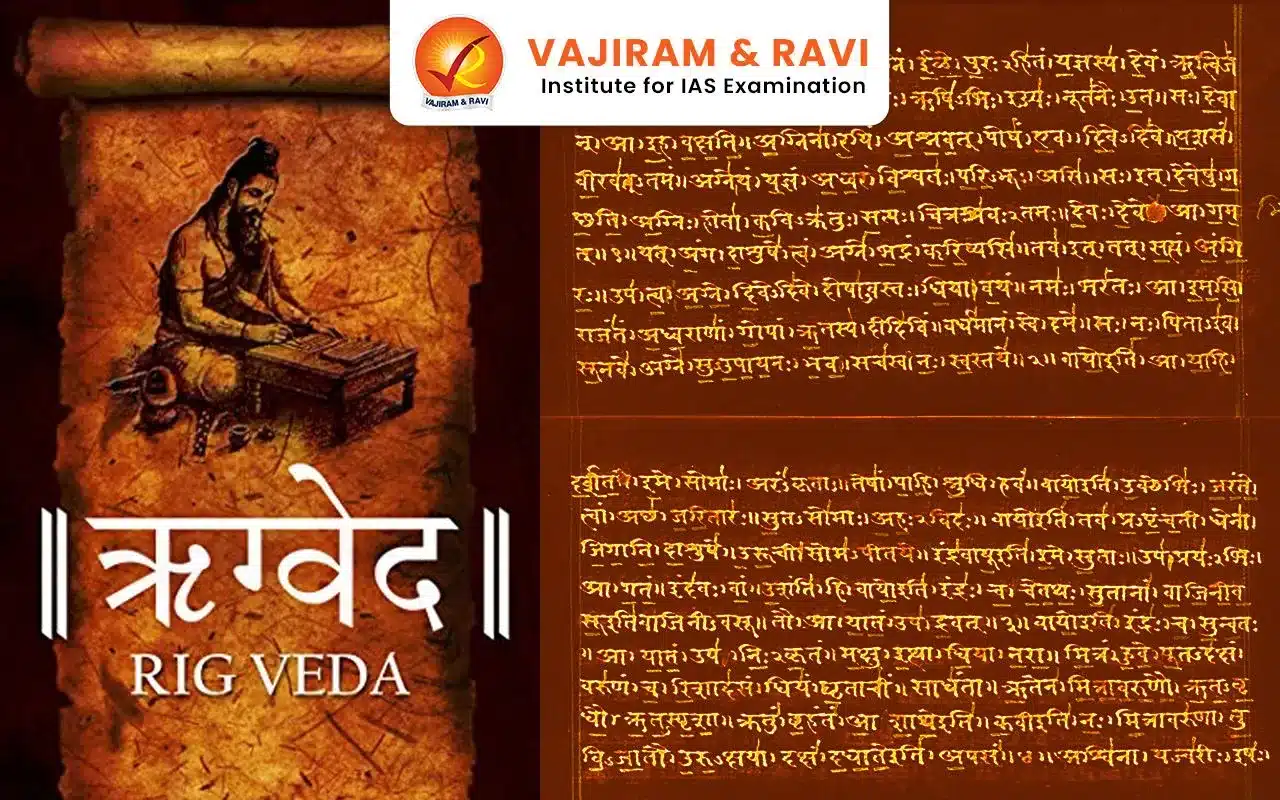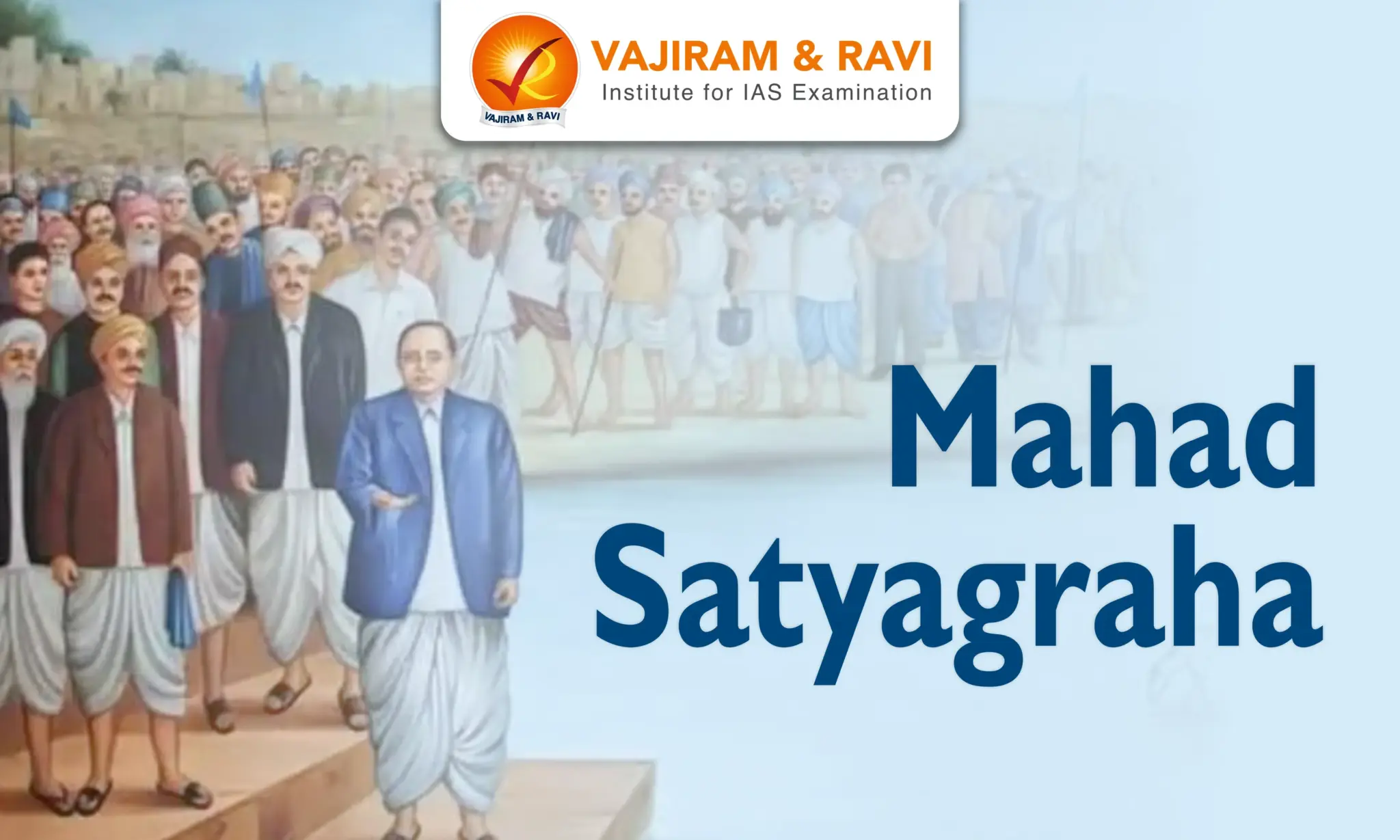The Rigveda is the oldest and most sacred Hindu scripture, composed in Vedic Sanskrit around 1500-1000 BCE. It contains 1,028 hymns and 10,600 verses organised into 10 books (mandalas). The Rigveda explores themes such as ritual and sacrifice, cosmology and creation, and the role of deities like Indra, Agni, and Soma.
The Rigveda provides insights into early Vedic society, which was pastoral and agrarian, with a semi-nomadic tribal structure and a patriarchal family system. The text also touches upon the polity, with a tribal chief at the centre and the emergence of monarchy in later Vedic periods. Recognising its universal value, UNESCO has listed the Rigveda as part of the World Human Heritage.
Rig Veda History and Compilation
The Rig Veda is an ancient collection of Vedic Sanskrit hymns. It is one of Hinduism's four sacred texts and ranks among the world's oldest scriptures.
- Composition period: The hymns that comprise the Rigveda are estimated to have been composed over a vast period from ~1500 BCE to 1000 BCE.
- However, the compilation into the canonical text likely occurred between 1200 BCE and 900 BCE.
- Oral tradition: Hymns were preserved through generations by Brahmin families using advanced oral tradition techniques, which included mnemonic devices, lyrical composition patterns, pitching accents, and melodic recitation.
- Rishi families: Prominent families of ṛiṣhis (sages) are credited with composing the hymns.
- These ṛiṣhi clans include Kashyapa, Atri, Bharadwaja, Vishwamitra, Gautama, Jamadagni and Vasishta.
- Surviving shakhas: Out of the original five shakhas (recensions), only two have survived: the Sakalya and Baskala.
- Associated texts: These recensions are accompanied by Brahmanas and Upanishads, which the same ten Rishi families authored over centuries.
| Rig Veda | |||
| Sakhas/Schools | Commentaries | ||
| Baskala | Aitareya Brahman | Aitareya Aranyakas | Aitareya Upanishads |
| Sakalya | Kaushitaki Brahman | Kaushitaki Aranyakas | Kaushitaki Upanishads |
Vedic Texts
- The Vedic text is a complex amalgamation of four types of texts woven into its fabric:
- Samhitas: The core layer containing the poetic hymns.
- Brahmanas: Prose commentaries on the hymns.
- Aranyakas: Ritual interpretations for hermits.
- Upanishads: Philosophical texts on spiritual knowledge.
Rig Veda Structure and Components
The Rigveda is divided into 10 mandalas. Each mandala is further divided into suktas (hymns) and verses. In total, the Rigveda contains around 1,028 suktas and over 10,600 verses. The mandalas are not arranged chronologically, but rather by length and content.
- Notable highlights of the mandalas:
- Mandala 1 (191 hymns) is primarily dedicated to deities like Agni, Indra, and Varuna. This includes the philosophical Riddle Hymn, which influenced later Upanishads such as the Mundaka.
- Mandala 2 (43 hymns): It focuses on Agni and Indra, attributed to Rishi Gṛtsamada Śaunahotra.
- Mandala 3 (62 hymns): It hymns to Agni, Indra, and the Vishvedevas, with the significant inclusion of the Gayatri Mantra.
- Mandala 4 (58 hymns): It comprises hymns to Agni, Indra, and Rbhus, among others, attributed to Vāmadeva Gautama.
- Mandala 5 (87 hymns): It addresses Agni, Indra, Visvedevas, Maruts, and twin-deity Mitra-Varuna, mainly attributed to the Atri clan.
- Mandala 6 (75 hymns): It is dedicated to Agni, Indra, and a broad range of deities, associated with the Bārhaspatya family of Angirasas.
- Mandala 7 (104 hymns): It contains hymns to Agni, Indra, Visvadevas, and other deities, attributed to Vasiṣṭha Maitravaruṇi.
- Mandala 8 (103 hymns): It includes various hymns to different gods, with the Vālakhilya hymns considered apocryphal.
- Mandala 9 (114 hymns): It is exclusively devoted to Soma Pavamana, related to the sacred potion in Vedic rituals.
- Mandala 10 (191 hymns): It contains later language hymns to Agni, Indra, and others; includes significant hymns like the Nadistuti sukta (praise of rivers) and the Nasadiya sukta (speculations on creation).
| Maṇḍala | Deities | Key Ṛṣis |
| Mandala 1 | Agni, Indra | Madhuchchhandas, Medhatith, Gotama and others |
| Mandala 2 | Agni, Indra | Gṛitasamada and His Family |
| Mandala 3 | Agni, Indra | Vishvamitra and His Family |
| Mandala 4 | Agni, Indra | Vamadeva and His Family |
| Mandala 5 | Soma | Atri and His Family |
| Mandala 6 | Agni, Soma | Bharadvaja and His Family |
| Mandala 7 | Agni, Indra | Vashiṣṭha and His Family |
| Mandala 8 | Various | Kanva, Angriva and their family |
| Mandala 9 | Soma | Kaśyapa, Soma Devata and others |
| Mandala 10 | Agni, Indra | Vimada, Indra, Shachi and others |
Rig Veda Significance
The Rigveda is considered one of the most sacred texts of Hinduism, and its significance extends beyond its historical and cultural importance.
- Philosophical and spiritual significance: The Rigveda is primarily concerned with the worship of Hindu deities such as Surya, Indra, Rudra, Vayu, Agni, Vishnu, and others.
- The Rigveda mentions several female deities, with Ushas, the dawn goddess, being the most celebrated, along with Aditi, Prithvi, Rathri, Sarasvathi, and Vageshvari (Vac), but none are central to the text.
- The hymns and stories within the Rigveda reflect the Hindu philosophy and belief system.
- They were used for ritualistic purposes in ceremonies likemarriages and to ward off illness and negativity.
- The text addresses issues of morality and righteous societal behaviour, tackling topics like gambling and good governance.
- Geographical and cultural significance: The Rigveda contains significant references to the geographical features of the Indian subcontinent, including mentions of rivers, seasons, and other natural phenomena.
- The instructions and teachings of the Rigveda influenced life in the subcontinent for centuries, outlining the duties of the different social classes and emphasising the importance of religion, worship, sacrifices, and religious rituals.
- Cultural legacy: The Rigveda and its scriptures remain deeply rooted in Hindu culture, with many verses and prayers still recited on auspicious occasions. It is one of the world's oldest religious texts still in use today, with an impact on Hinduism and Indian culture.
- UNESCO: The Rigveda manuscripts have been included in UNESCO's Memory of the World Register, a compendium of documentary heritage of exceptional value, recognising their global significance and the need to preserve this invaluable cultural treasure.
Rig Veda UPSC PYQs
Question 1. With reference to the difference between the culture of Rigvedic Aryans and Indus Valley people, which of the following statements is/are correct? (UPSC Prelims 2017)
- Rigvedic Aryans used the coat of mail and helmet in warfare whereas the people of Indus Valley Civilization did not leave any evidence of using them.
- Rigvedic Aryans knew gold, silver and copper whereas Indus Valley people knew only copper and iron.
- Rigvedic Aryans had domesticated the horse whereas there is no evidence of Indus Valley people having been aware of this animal.
Select the correct answer using the code given below:
(a) 1 only
(b) 2 and 3 only
(c) 1 and 3 only
(d) 1, 2 and 3
Answer: (c)
Last updated on November, 2025
→ Check out the latest UPSC Syllabus 2026 here.
→ Join Vajiram & Ravi’s Interview Guidance Programme for expert help to crack your final UPSC stage.
→ UPSC Mains Result 2025 is now out.
→ UPSC Notification 2026 is scheduled to be released on January 14, 2026.
→ UPSC Calendar 2026 is released on 15th May, 2025.
→ The UPSC Vacancy 2025 were released 1129, out of which 979 were for UPSC CSE and remaining 150 are for UPSC IFoS.
→ UPSC Prelims 2026 will be conducted on 24th May, 2026 & UPSC Mains 2026 will be conducted on 21st August 2026.
→ The UPSC Selection Process is of 3 stages-Prelims, Mains and Interview.
→ UPSC Result 2024 is released with latest UPSC Marksheet 2024. Check Now!
→ UPSC Prelims Result 2025 is out now for the CSE held on 25 May 2025.
→ UPSC Toppers List 2024 is released now. Shakti Dubey is UPSC AIR 1 2024 Topper.
→ UPSC Prelims Question Paper 2025 and Unofficial Prelims Answer Key 2025 are available now.
→ UPSC Mains Question Paper 2025 is out for Essay, GS 1, 2, 3 & GS 4.
→ UPSC Mains Indian Language Question Paper 2025 is now out.
→ UPSC Mains Optional Question Paper 2025 is now out.
→ Also check Best IAS Coaching in Delhi
Rig Veda FAQs
Q1. What is the Rig Veda?+
Q2. How many hymns does the Rig Veda contain?+
Q3. What topics are covered in the hymns?+
Q4. How is the Rig Veda important?+
Q5. How is the Rig Veda still used today?+

















